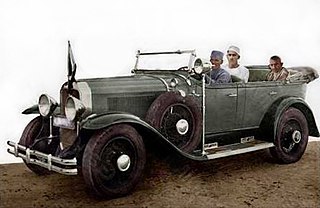Related Research Articles

The Non-cooperation movement was a political campaign launched on 4 September 1920, by Mahatma Gandhi to have Indians revoke their cooperation from the British government, with the aim of inducing the British to grant self-governance.

Sumitranandan Pant was an Indian poet. He was one of the most celebrated 20th century poets of the Hindi language and was known for romanticism in his poems which were inspired by nature, people and beauty within.

Chandrashekhar Sitaram Tiwari (pronunciation , popularly known as Chandra Shekhar Azad, was an Indian revolutionary who reorganised the Hindustan Republican Association under its new name of Hindustan Socialist Republican Association after the death of its founder, Ram Prasad Bismil, and three other prominent party leaders, Roshan Singh, Rajendra Nath Lahiri and Ashfaqulla Khan. He hailed from Badarka, Unnao in Uttar Pradesh and his parents were Sitaram Tiwari and Jagrani Devi. He often used the pseudonym "Balraj" when signing pamphlets issued as the commander in chief of the HSRA.

The Pratapgarh district is one of the districts of Uttar Pradesh state of India, and Pratapgarh city is the district headquarters. Pratapgarh district is a part of Allahabad division. The total area of Pratapgarh district is 3730 Sq. Km.

Aruna Asaf Ali was an Indian educator, political activist, and publisher. An active participant in the Indian independence movement, she is widely remembered for hoisting the Indian National flag at the Gowalia Tank maidan, Bombay during the Quit India Movement in 1942. Post-independence, she remained active in politics, becoming Delhi's first Mayor.
Maurice Frydman, aka Swami Bharatananda, was an engineer and humanitarian who spent the later part of his life in India. He lived at the ashram of Mahatma Gandhi and took an active part in India's fight for independence—notably in helping to draft a new constitution for the State of Aundh that became the Aundh Experiment. He was a Polish Jew who subsequently converted to Hinduism.

Bettiah Raj was the second-largest zamindari in the region of India now known as Bihar. It generated annual land revenue rentals of more than 2 million rupees.

Brajesh Singh was an Indian politician belonging to the Communist Party of India (CPI). He hailed from the royal family of Kalakankar near Allahabad and his nephew Dinesh Singh was a minister in the Indian cabinet.

Vijay Singh Pathik, popularly known as Rashtriya Pathik, was an Indian revolutionary. He was among the first Indian revolutionaries who lit the torch of freedom movement against British rule. Much before Mohandas K. Gandhi initiated the Satyagrah movement, Pathik experimented during the Bijolia’s Kisan agitation. After being implicated in the Lahore conspiracy case in 1915, he changed his name to Vijay Singh Pathik. His grandfather's sacrifice in the struggle of 1857 in Bulandshahr district, affected him deeply to be freedom fighter.
Thakur is a historical feudal title of the Indian subcontinent. It is also used as a surname in the present day. The female variant of the title is Thakurani or Thakurain, and is also used to describe the wife of a Thakur.

Vellalore Annaswamy Sundaram was an activist in the Indian Independence movement, an associate of Mahatma Gandhi, a confidant of Madan Mohan Malaviya, and a fundraiser and secretary to the Benares Hindu University (BHU). His work focussed on communication and public relations, with particular emphasis on an international and intercultural perspective.
Pratapgarh was a Rajput estate or Jagir of Oudh, India. The rulers of the estate were originally ruling from a place known as Taroul or Tiroul near Allahabad. The ancestor of the family was Babu Sujan Shah, son of Raja Sangram Shah of Tiroul. Later a descendant, Babu Pratap Singh (1628–1683) came to the region known as Rampur and built a fort, and gave the city its current name, Pratapgarh.
Raja Pratap Bahadur Singh (1889–1921) was a Rajput ruler of Pratapgarh of Oudh, India.

Raja Awadhesh Singh was zamindar of Kalakankar estate of Oudh of British India, succeeded by Raja Ramesh Singh.
Kunwar Medni Singh was a member of royal family of Pratapgarh of Oudh, British India. He established a town near Pratapgarh of Uttar Pradesh, at present known as Katra Medniganj after him.
Rai Sarabjit Singh (1853-1910) was the ruler of Bhadri of Oudh, belongs from Bisen family, succeeded on 15 February 1878 after the death of the late Rai Jagat Bahadur Singh. He received the hereditary title of Rai from the British government in November 1879. His property was taken under the management of the Court of Wards in 1867, on account of minority and indebtedness of the owner, and released in 1878. The Bhadri taluqa was well managed by Sarabjit Singh, who left it practically unencumbered. Later estate was ruled by Rai Krishna Pratap Singh.
Rai Jagat Bahadur Singh was the ruler of princely Bhadri state of Oudh. After the murder of Rai Jagmohan and his son Bishnath by Nazim at Ramchaura Ghat on the bank of Ganges, Bhadri was then given to Amarnath Singh, nephew and adopted son of Rai Jagmohan Singh, who was succeeded by his adopted son, Jagat bahadur Singh, whose father Sheoratan Singh, was hanged at Allahabad in 1857. Jagat Bahadur Singh also died without issue, and adopted Rai Sarabjit Singh, who received the hereditary title of Rai from the British government in November 1879.

Bhadri was an estate (taluqdari) of Oudh, British India. The Taluqdari was controlled by Bisen clan of Rajputs. Now it is part of Pratapgarh district in Uttar Pradesh, India.

Raja Rampal Singh was a ruler of Kalakankar estate of Oudh from 1885 to 1909. Rampal Singh was a Congress sympathizer. He was one of the founding member of Indian National Congress Party. In consequence, Mahatma Gandhi and other congress leader used to visit him quite frequently. Pandit Madan Mohan Malviya had very intimate relations with Raja of Kalakankar. The Raja Saheb of Kalakankar had started a Hindi weekly, Hindusthan, in 1883 to spread the message of freedom.
Kunwar Singh (1777–1858) was one of the leaders during the Indian Rebellion of 1857.
References
- ↑ Roper Lethbridge (2005). The golden book of India (illustrated ed.). Aakar. p. 453. ISBN 978-81-87879-54-1.
- ↑ Srilal Shukla (2005). Bhagwati Charan Verma, Volume 209 (illustrated ed.). Sahitya Akadami. p. 453. ISBN 978-81-87879-54-1.